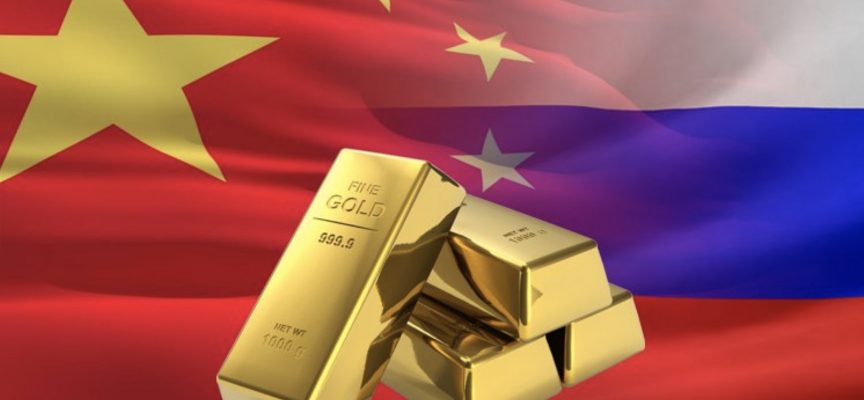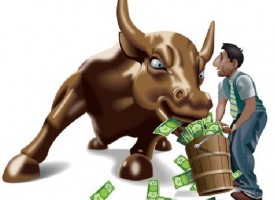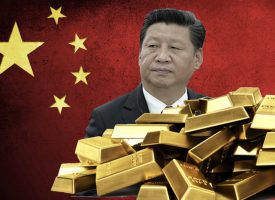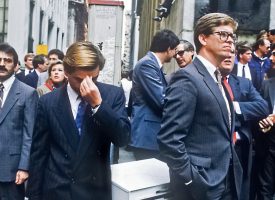Today the man who is connected in China at the highest levels said that the price of gold is headed to new all-time highs from here, despite the ongoing volatility.
Gold is replacing the dollar
August 3 (King World News) – John Ing: It has been a jittery few months for investors as an ill wind not Canadian wildfire smoke, US heatwaves, or flash floods swept through financial market here, there and everywhere. The failure of a “too-big-to-fail” global bank and a few US institutions was one of the causes of the financial crisis this year. Another was the US debt ceiling ping-pong negotiations, which reduced investor confidence as Congress prevented a national default for an additional two years. With an agreement, the US Treasury embarked on a $1.1 trillion borrowing binge, which was made more challenging by China’s absence, which had previously been the main buyer. Following the spike in borrowing rates, yields increased in anticipation of the flow of debt, affecting the roughly 4,000 smaller regional banks now competing for limited depositors. Then, the Fed raised rates to levels unseen in 22 years. Also disregarded, the ratio of global gross debt to GDP is now 17% larger than it was just prior to the 2008 Lehman crisis according to the Institute of International Finance.
Nonetheless investors have piled into the stock market to book the best seven months in decades, pushing it close to all-time highs on the fear of missing out (FOMO) on expectations that inflation is slowing, raising hopes that the Fed will not raise rates again. However, the US economy grew at an unexpected 2.4% annual rate in the second quarter. Inflation is very much alive and that much feared recession is nowhere in sight.
The battle against “elevated” inflation is not over and its demise is greatly exaggerated, particularly since governments keep adding fuel to the fire by running up huge deficits and debt. Inflation psychology has set in. Not slowing down, are wage settlements which are in double-digit territory, aided by the lowest national unemployment rate since the 1960s. Business has been able to expand margins aided by inflation. Climate change is pushing up food and energy prices. A trinity of cultural phenomenons, Swiftflation, Barbie, and Beyonce have even helped the economy, raising US consumer confidence to two-year highs. Central bankers who earlier underestimated the scale and persistence of inflation have glossed over their role but not slowing down is government spending and the financing of their governments’ deficits and the trillions of unprecedented pandemic stimulus packages that amounted to more than 20% of GDP. That infusion of cash, contributed to growth and inflated stock prices, but also resulted in the highest inflation in decades, reminding us of noted economist Milton Friedman’s observation that inflation is, “always and everywhere a monetary phenomenon.”
Bidenomics’ New Deal
For starters, reluctant to make the same mistake twice, central banks have maintained a tight stance to chill demand but failed to realize the consequences of raising rates to quell inflation. Although in the early stages of rate increases, the spate of banking crises shocked bankers and the continuation dooms us to another sharp rise in debt as far as the eye can see. Only weeks after a new debt limit, the national debt topped $32 trillion. The non-partisan Congressional Budget Office (CBO) projected debt to GDP at 100%, presenting a dilemma for the Treasury as it attempts to finance the deficits at a time when the Fed’s own quantitative tightening program drains the system of almost $100 billion every month.
The bottom line is that deficit financing is inflationary and while President Biden has yet to develop a supply-side strategy, after spending trillions on pandemic relief, his sweeping Bidenomics industrial strategy will cost trillions more of new spending on infrastructure, green technology and semi-conductor chips, which will give inflation yet another boost, ensuring future rate increases. No wonder barely a third of Americans approve of Mr. Biden’s economic package…
ALERT:
Legendary investors are buying share of a company very few people know about. To find out which company CLICK HERE OR ON THE IMAGE BELOW.
 Sponsored
Sponsored
It’s Not Just Inflation
A further issue is the growing role of artificial intelligence (AI) for which a faction argues that controls are needed because AI has the potential to undermine democracy and its institutions. Yet AI has been around for the past decade (Siri, Alexa etc.) with machines that write code, text, create images and even negotiate. While there is the need for some intelligence in Washington, of concern is that a new era of interactive disinformation has replaced truth or untruths, particularly during elections where there is little control over data, how or when it is used. AI and social media are a toxic combination. No wonder it has found a home in politics.
Inflation particularly is made worse by the social activism of governments, led by Biden’s nation- centered “greening of America”, in an attempt to make it great again. All of this represents a sea change or pivot in America’s political economy. Almost a half century ago, Ronald Reagan introduced a supply-side policy focusing on free markets and free trade policies. It worked. Today, to curb America’s appetite for fossil fuels, Mr. Biden’s costly “greening of America” is a repudiation of this past, replaced by a “government knows best” and today the cost keeps mounting. A good example in building “fortress” America, Mr. Biden has launched a new era of nationalism, waged a cold war with China and a cultural war at home which could bankrupt the nation. Mr. Biden even kept the punitive Trump tariffs, which are a hidden tax on each American household, lifting inflation. Spending is spending. With Mr. Biden willing to spend, bail-out and backstop just about everything, the US simply cannot afford it.
Spending is Spending
Mr. Biden promises a big industrial plan as part of his bid for reelection next year that would pour hundreds of billions of dollars in subsidies into American manufacturing and clean technology at the expense of allies in Europe, Asia, and Canada. The action implements so-called “free trade” principles, but it also sparks an inflationary “arms race” to counteract his expensive Inflation Reduction Act (IRA). Ironically, 60% of the spending so far has gone to overseas companies with 15 of the 20 largest expenditures for battery installations, according to the Wall Street Journal. India has claimed that US plans to support renewable energy are a new kind of protectionism similar to those of the Great Depression and hurdles to the developing world. In the meantime, as America’s expensive military industrial complex ramps up to increase production of everything from aircraft to tanks, that other “arms race” keeps economic growth very much alive. And of course, there are still billions of dollars of stimulus funds sitting in US savings accounts, increasing the government’s economic footprint.
In an effort to reduce emissions, leaders at the most recent G7 summit decided that fossil fuels were on their way out. To make the switch from gas-powered vehicles, automakers have spent hundreds of billions building new electric models, battery factories, and new factories. One in five new cars sold this year, up from one in 23 just three years ago will be an EV, according to the International Energy Agency (IEA). This is a goal, but the reality is that there are currently 3 million EVs on the road and only 139,000 public charging stations, of which only 32,000 are fast- charging types (under 30 minutes). Despite the need for ten times as many chargers by 2030, the EU only has 300,000 of them. Notably, the majority of EVs are found in China, which occupies a prominent position as the world’s largest producer and market of EVs, accounting for 60% of EV sales with around 1.8 million charging stations. China was an early adopter investing heavily in EVs, just as they are in technology.
Mission Critical
Consequently, Mr. Biden’s green plans is playing catch-up, pushing EVs as a part of a major investment in American manufacturing, but if successful, his automobile industry which accounts for 5% of America’s GDP or $100 billion per year in exports, could be a major casualty. Ironically if Mr. Biden succeeds, the US would be more dependent on China for critical minerals and the rare earths making the US reliant on its foe. Other problems include the shortage of long-life batteries, the skyrocketing cost of critical materials and even shortages of capacity of America’s aging power grid which ironically remains largely based on the burning of carbon (coal and gas). Moreover, if politicians and scientists are right about the penetration of EVs, the world would need three to four times more lithium and processing than the world produces which would require hundreds and hundreds of mines.
With supply a problem, what about demand? The public, it seems is not so gullible. A US government study found that one-quarter of EV buyers went back to internal combustion vehicles. And what would happen if Detroit builds EVs and no one comes? At least we will have enough batteries.
To decarbonize the world, almost $2 trillion is being spent on clean technology, energy storage, nuclear as well as the aforementioned EVs, according to the IEA. However, Bain & Co. found that a majority of the projects do not meet acceptable economic returns and thus are likely to stifle broaden acceptance, unless heavily subsidized from the billions of Biden’s IRA which does nothing ironically to stifle inflation, instead feeds the inflation dragon with its pot pourri of spending. Still, the fire hose of renewable spending was not enough to save the business models of the four big wind turbine builders, GE Renewable Energy, Nordex, Siemans Gamesa and Veslas which supplies 90% of the market outside China, reported almost $6 billion of losses due to permitting, Chinese competition and poor economics. After receiving millions in subsidies, America’s sole cobalt mine just closed. America’s greening under Mr. Biden is currently in the red…
This silver explorer recently did a huge transaction with a $4.5 billion market cap producer CLICK HERE OR ON THE IMAGE BELOW TO LEARN MORE.
The End of US Hegemony
The problem is that in moving into this era of global competition, America’s unipolar global dominance is being challenged, when its financial house is not in order. The China-US Cold War divided the world, and Russia’s invasion of Ukraine has upended that division. In the meantime, trade between Russia and China has soared, and India has surpassed China as Moscow’s top buyer for Russian oil and arms, helping to counteract Western embargoes.
The Middle East too has regained its pivotal position, not with oil but with financial power as a flurry of world leaders visit Jeddah seeking help from PGA golf to footballers to a Ukraine peace initiative. Saudi Arabia is set to host Ukraine peace talks. The zigging of American foreign policy when it should have been zagging has added to the cynicism of what America says and does. As an example, President Biden fundamentally altered the decades-old relationship with Saudi Arabia, castigating them for cutting back oil production (as is their sovereign right) and then threatening to turn the state into a “pariah”, when journalist Jamal Khashoggi was murdered in 2018. Biden warned there would be consequences.
Yet when China stepped into the void that was once the exclusive domain of the United States, Secretary of State Blinken scrambled to visit Saudi Arabia on the heels of Chinese President Xi Jinping’s visit that paved the way for a Chinese oil for renminbi deal that replaced petrodollars as well as the signing of a stack of commercial agreements. That visit changed one of the most important geopolitical alliances and diplomatically marginalized American influence. To make matters worse for Biden, the Saudis then ignored Biden’s request to boost production, instead cut back output which resulted in the drawdown of the US Strategic Petroleum Reserve that caused a one-off drop in energy and inflation but exposes the US to higher prices as the reserve is at the lowest ever. And today, Russia, Iran and Venezuela which account for 40% of OPEC+’s proven oil reserves are selling oil to both China and India, replacing Europe. As a result, Russia has topped Saudi Arabia as the world’s largest supplier of oil. What followed next was that India in turn weaponized its rice exports, putting a ban amid concern over food price inflation just when Russia withdrew from Ukraine wheat deal. Yes, there were consequences.
China Syndrome
Despite recent high-level meetings, the two superpowers have yet to re-establish a connection and can’t even manage a working relationship. And current efforts have yet to put a “floor” under the relationship because of a paranoic mistrust. The precarious state of affairs is a consequence of a shift from economics and trade to defense and security. Beijing’s assertiveness to act as a Ukraine- Russia peacemaker, followed the successful mediation between Saudi Arabia and Iran. Each move was greeted by the US with skepticism because it erased another aspect of US influence. That estrangement has brought Russia into China’s orbit, frustrating Biden’s efforts to contain China as Europe’s leaders have opted instead to “de-risk” the relationship, with its leaders visiting Beijing to deepen economic ties. The bitter rivalry between the two superpowers has made business a political lightning rod. Caught in the middle and despite tensions, there has been a parade of US multinational CEOs including “old friend” Bill Gates, visiting Beijing because for them China remains a vital largest or second largest market.
While Biden’s attempt to thaw relations have turned into a polar vortex, another old friend, centenarian former Secretary of State, Henry Kissinger issued a dire warning, “We are on the path to great power confrontation.” Subsequently Mr. Kissinger who played a key role in normalizing relations between China and the US over a half century ago, recently visited Beijing as a private citizen, meeting top diplomat Wang Yi and Chinese President Xi Jinping who echoed, “China and the United States are once again at the crossroads of where to go, and the two sides need to make new decisions”.
For years to keep the world in balance, American foreign policy was to isolate its foes. Going back to the Bill Clinton years, India was the keystone to keep China occupied over its borders with Russian help. That has changed. China has become India’s largest trading partner. The Ukraine war has forced Russia into China’s arms and a strategic trilateral partnership of India, Russia and China, across the world’s largest land mass has been formed, fostering supply, energy and agriculture networks that both lessens US influence and is beyond reach of its currency. It is this Eurasian coalition that is leading to the expansion of the BRICS group to reduce their dependance on the West.
At the upcoming summit in South Africa, the BRICS (Brazil, Russia, India, China and South Africa) coalition may be divided over the war in Ukraine but are united on lessening American hegemony. First the BRICS bloc keeps expanding with more than 20 countries applying for membership and there is talk of implementing a gold-backed international BRICS trading currency as a competitor to the dollar, ending their dependence bringing them closer to China. Four of the BRICS nations are top gold producers and the BRICS’ combined holdings are 5,400 tons, second only after the United States. Recently 22 countries of the BRICS coalition opened accounts to trade in Indian Rupees instead of dollars, lessening again the influence of the dollar. Today the BRICS alliance’s economic footprint has overtaken G7 economies (US and its allies) in global GDP and own a larger share of natural resources. What is clear is that the old-world order is dead and we are in a fractured caldron of shifting powers…
ALERT:
Powerhouse merger caught Rio Tinto’s attention and created a huge opportunity in the junior gold & silver space CLICK HERE OR ON THE IMAGE BELOW TO LEARN MORE.

US and China Already at War
With fundamental differences between China and the US on how the global economy should work, China with 1.4 billion consumers has seen its economy’s momentum stall by sagging foreign investment sentiment, exacerbated by the tensions with US. In the last quarter, China’s GDP grew 6.3% despite lockdowns and a souring real estate sector, and although its post pandemic reopening is faltering, China’s $18 trillion economy generated more than 20% of world output, while the G7 share has fallen from 44% to 30%. While China remains the manufacturing workshop for the world and the US on the other hand a consuming country, both are pushing for globalization, except with each other. Why?
Realpolitiks.
China believes that US hegemony is in a state of decline, suffering from a divided state of America, weakened under the weight of too much debt and that Washington’s sanctions and export controls are an effort to contain and isolate China. Since geopolitics plays an outsized role in the global economy, from the US point of view, close China and Russian ties as well as the Taiwan Straits are large contributors to the decoupling debate. President Biden calling China’s leader Xi Jinping a “dictator,” only days after attempting to cool tensions after Blinken’s denial that the US is not trying to contain China, did not help matters.
In the competition of systems, tensions between China and the US were further exacerbated by the “chip wars” that sees the West “suck and blow” as the US tries sanctions and export controls to restrict access to critical technologies and free themselves from their reliance on the critical minerals crucial for battery technology. Tiny semi-conductor chips have become pawns in the great power competition. China is the largest market for sophisticated chips and Western producers have been stymied by President Biden’s embargo, effectively shut out, removing a key market. Most of the world’s leading-edge chips are made in Taiwan but the US Chips Act provides up to $52 billion of funding to create advanced chips which forces the West to develop and subsidize the making of advanced chips domestically, making them ironically hugely dependent on China which has a strong grip in the production of the critical minerals needed in modern-day technology.
Decoupling thus will take time and prove costly. China has retaliated against Mr. Biden’s curbs putting a ban on US memory chipmaker Micron in a tit-for-tat retaliation as well as restricting exports of gallium and germanium which weaponizes their dominance of critical minerals. And with China mining nearly three quarters of global rare earths (REE), processing 60% of world’s lithium and 80% of world’s cobalt, China has the lion’s share of the world’s critical minerals used in electric batteries. Taiwan is the world’s largest chipmaker and is the ham in the sandwich as the more cutting edge or high-end chips required by industry groups, resides not only in Taiwan but South Korea, China and Japan. While China’s global clout is rising fast, China is also a world leader in artificial intelligence with its own chips, machines and manufacturing capacity. Chip wars are spreading, which will fuel inflation.
Quid Pro Quo
The offensive perimeter in China’s backyard is part of the American strategy to economically and militarily contain China, starting with forces in Taiwan, which is only 90 miles from Chinese shores, Okinawa, marine bases in Japan, nine American bases in the Philippines, submarines in Australia, and bases in Indonesia. In the western Pacific, the US now has bases or access in 19 locations, whilst China has a solitary military post in the African nation of Djibouti.
China’s strategy on the other hand appears to be more commercial, supplying the biggest trading non-aligned countries with China’s resources, using the renminbi instead of dollars. The country has reached into its storied Silk Road past to build strategic ties in the future, based on the Belt and Road mercantilism. And trading with others like Latin America, China today has allies in the south of United States including Ecuador, Panama and Costa Rico, and counters America’s efforts with ties to Cuba, only 90 miles from US.
Economically powerful, China’s competitive edge is dictated by trade flows. China’s trade with Latin America has exploded from $12 billion in 2000 to over $495 billion in 2022. China has become South America’s biggest trading partner, displacing the United States. China has also signed free trade deals with Chile, Peru and Costa Rico, whilst Europe has spent some 20 years negotiating a deal that is not even ratified. At the same time, the United States has a patchwork of trade agreements yet nothing like United States, Mexico and Canada Trade Agreement (USMCA)…
This Is Now The Premier Gold Exploration Company In Quebec With Massive Upside Potential For Shareholders click here or on the image below.
Although Anthony Blinken reiterated that the US is committed to the “One China” policy which has guided Washington since 1979, he stated, “we do not support the independence of Taiwan”, but did not explain his government’s crossing of redlines on Taiwan, after almost a half century of detente. Both sides have reinforced each other’s worst-case assumptions, leading to the escalation of the war of words. Nor does the demonization of everything Chinese help with Congress and some states’ attempting to restrict property purchases by Chinese citizens, echoing the xenophobic laws of yesteryear or Canada’s Chinese Exclusion Act a century ago. Dialogue is badly needed. Blinken’s visit, the first by a US secretary of state since 2018 is a start towards putting a “floor” under a turbulent relationship. The future of global stability and prospect depends on it, because next year the second act of Trump II is likely to prove more confrontational.
The deterioration between the two superpowers has led to concerns that the US is suffering the same fate as Rome in the fifth century with the US falling into the Thucydides’ Trap. According to Harvard professor Graham T. Allison, that in 12 of 16 episodes when an emerging power threatened an existing power, the end result ended in bloodshed. Consequently today at a minimum, both sides should declare that neither wants a war since the relationship between the two superpowers will determine humanity’s fate in the current 21st century.
Fiat Inflation in the United States
As for inflation, we have been through this before. In 1981-1982 and 2008 when after a bout of rising inflation, tighter US monetary conditions contributed to market collapses and declining asset prices. Eventually consumer prices fell back as did the dollar. The concern today is that with inflation near 40-year highs, where will the money come from to fund America’s debt and deficit spending, particularly with Mr. Biden’s playbook of stimulus?
Mr. Biden has run up the country’s debt with the biggest spending blitz ever. Bidenomics is repeating the mistakes of the Johnson “guns and butter” era which was one of the biggest drivers of inflation that ended in near hyperinflation in the seventies. As history showed, rates will need to remain higher than inflation to work. The US economy is saddled with widening twin deficits and near record debt which has left a debt service problem, and an inverted yield curve. In July 2021 according to estimates from the Congressional Budget Office, government debt service costs for 2022-2023 will cost $5.43 trillion. But the other month, they raised the interest burden cost for 2024-2033 to almost $11 trillion, or more than the US spends on defense.
Following the regional bank bankruptcies, a funding crisis for the commercial real estate sector is imminent as some $1.5 trillion of commercial mortgages come due over the next three years. The sale of Canary Wharf, Brookfield’s and Blackstone’s default on mortgages coupled with rock bottom occupancy rates are making ghost towns the new norm. San Francisco alone faces defaults on billions of dollars of debt after the owners of the city’s largest retailers, hotels and shopping centres hand back the keys on once valuable real estate. With half of America’s small banks currently insolvent, there are the big losses to come. In the first quarter, FDIC data showed America’s banks posted half a trillion in unrealized losses.
Guns and Butter May Be Tip of Debt Iceberg
Debt is the bedrock of the American economy. The shifting global recovery has hollowed out America’s industrial base. And although the Republicans were pushing for trillions of spending cuts, the so-called new debt agreement called for a reduction in US spending of a paltry $136 billion over the next two years, a rounding error which of course does nothing for America’s growing long-term debt problem. And, when faced with the prospect of a global meltdown, both parties screamed “chicken”, kicking the can down the road yet again, leaving the weaponization of the debt limit to be used for another day. As a result, instead of higher taxes or spending cuts, this government will just try to borrow more money and get deeper in debt which caused credit rating agency Fitch to downgrade US debt. And worse, to finance the spending blitz, the US must look to others to finance.
America’s debt keeps mounting amid the cold war, a cultural war, trade war and green war, which raises a refunding risk at a time when corporation and households must also rollover their pile of debt. The baby boomers are now senior boomers and with 64% of the budget tied to the cost of Medicare and Medicaid, Capital Hill’s spending scorekeeper CBO keeps sounding the alarm. However, with US Treasury debt already at a hefty 100% of GDP and Biden’s budget deficit over a trillion dollars for the fourth year in a row, both parties are in denial. Importantly, foreigners hold about one third of US debt with China the major investor. However, the increased geopolitical tensions has made future purchases unlikely. Then there is the political calculus that lies ahead when President Biden is up for re-election against Trump in a mega MAGA showdown. More to the point – who would then finance America’s looming deficits? Who will finance its debts? Hard times lie ahead.
After all, the Fed’s holdings are already at a whopping $8.3 trillion and they can’t infinitely expand its balance sheet without triggering hyperinflation. Already year to date, the Fed’s QE-driven book losses are in the hundreds of billions and operating losses a whopping $100 billion, exceeding the Fed’s capital base of only $42 billion. The Fed can’t finance America forever. The obvious answer is to reduce spending, which would lower the nation’s debt and allow the Fed’s record high balance sheet to shrink. However with western hegemony in decline and a rising China, Saudi Arabia and others, America cannot make itself great again by spending. The role of debt is a factor. Yes, this would entail choices – the choice between guns and butter. Consequently, that means that one day the US will face a financial crisis, without sufficient wealth to issue money or pay down debt. The result? Hyperinflation…
ALERT:
This company is about to start drilling what could be one of the largest gold discoveries in history! CLICK HERE OR ON THE IMAGE BELOW TO LEARN MORE.
Dollar’s Decline Underway
Of concern is that the US-China great power competition is a repudiation of the trading order which took the US decades to build and generated one of the biggest economic booms in history. Manufacturing supply chains and global finance have become highly integrated and will prove difficult to untangle. With rival China holding an edge in dominating supply chains, the fast- growing EV industry, critical minerals and finance, the cost to replicate is huge. Another reality is that the multi-polarity global order and the rising influence of the global East and global South led by BRICS+ will result in multi-order parallel institutions and, even currencies which would be more complementary, but at the expense of the West and the dollar. Already the Saudis, China and Russia are using other currencies in response to the freezing of assets and the weaponization of the dollar. While the US is trying to decouple from China, China and others are looking for ways to decouple from the dollar.
All this means that there is a need to rethink the western-led post Bretton Woods monetary order which fixed the dollar to the value of gold resulting in the dollar becoming the world’s reserve currency. By the 1970s amid the wreckage of the Bretton Woods system, President Nixon took the dollar off the gold standard and devalued the dollar. Today the weaponization of the dollar, superpower rivalry and growth of the global South and East has made the international financial architecture inherited from Bretton Woods obsolete. The global economy is transitioning from dollar hegemony toward a system where Asia and others wield greater power.
Sanctions and the freezing of $300 billion of Russian central bank’s dollar assets also eroded the dominance of the dollar which has gradually declined in value in recent decades as the US role in global trade wanes. Dollar usage has fallen to a 20-year low at 58% last year from 85% in 1978. The comical debt talks also weakened foreign investor enthusiasm as well as the weaponization of the greenback. Meantime China, the world’s largest holder of FX reserves at $3.2 trillion has diversified from the dollar, boosting its holdings in gold for the eighth straight month, holding over 2,300 tonnes. Japan and BRICS+ have been selling US treasuries. Decoupling works both ways.
Remember the Golden Rule
There is growing mistrust in America. Its exceptionalism is growing, but in a bad way, from its financial profligacy to its nationalism, to its political divisions, to the prospect of a Trump II. What damages trust in the US, damages the dollar. The safety of assets in US dollars is thus tenuous whilst dollar hegemony is being undermined daily by the Ukraine war, the rivalry with China, a crushing debt load and the cost of Biden’s greening of America.
The present system depends on the dollar. Without confidence in the dollar, the world has no valid reserve currency. Consequently, central banks are buying gold in record amounts, surpassing last year’s record purchases in an effort to diversify their holdings to avoid dollar debasement or even Russian style sanctions.
Inflation remains a global problem and it is increasing. Since 1971, when the dollar’s link to gold was severed, gold has outperformed both US consumer prices and other currencies, particularly as an alternative to the dollar, because unlike paper money, gold is sanction-free. Gold is a barometer of investor anxiety. We continue to believe gold will reach $2,200/oz. We also believe that the gold mining sector, which has been a performance laggard, will begin to attract investors as an alternative or hedge to the dollar. Gold shares are under-owned, and the seniors are poised to break out. Former US Fed chairman Alan Greenspan once said, “Gold still represents the ultimate form of payment in the world…gold is always accepted.”
Above all, despite the stock market’s premature celebration led by the “magnificent seven”, gold remains only $100/oz below its all-time high. What ballasts the US monetary system is debt. With governments using their printing presses to create the money to escape from drowning in debt, we believe that the structural weakness of the world’s leading currency makes the dollar vulnerable to a further loss in value, particularly since the US continues to consume more than it produces. Money isn’t infinite. Debt isn’t infinite. We believe that investors, fearing that America’s outsized debts and inflation problem will push borrowing costs even higher, will seek gold because it is a good index of currency fears, an alternative currency, and the ultimate insurance policy.
ALSO JUST RELEASED: Massive Russian And Chinese Gold Hoards Will Be Used To Back A Gold Currency CLICK HERE.
ALSO JUST RELEASED: Michael Oliver – Gold’s Oversold Reading And Why Bears Better Hope There Is No Upturn CLICK HERE.
ALSO JUST RELEASED: JP Morgan Has Become A Gold Bull CLICK HERE.
ALSO JUST RELEASED: Celente – People Are Suffering But This Is When Reality Will Hit CLICK HERE.
ALSO RELEASED: Gold & Silver Volatility Aside, Here Is The Global Backdrop CLICK HERE.
ALSO RELEASED: James Turk – This Is Silver’s Short Term Price Target CLICK HERE.
ALSO RELEASED: The Everything Bubble Is Bursting Now It’s All About Economic Survival CLICK HERE.
ALSO RELEASED: Michael Oliver Says Gold’s Breakout Is Very Real, Despite Volatility CLICK HERE.
To listen to Gerald Celente discuss the gold market as well as the collapse that has already begun CLICK HERE OR ON THE IMAGE BELOW.
© 2023 by King World News®. All Rights Reserved. This material may not be published, broadcast, rewritten, or redistributed. However, linking directly to the articles is permitted and encouraged.











